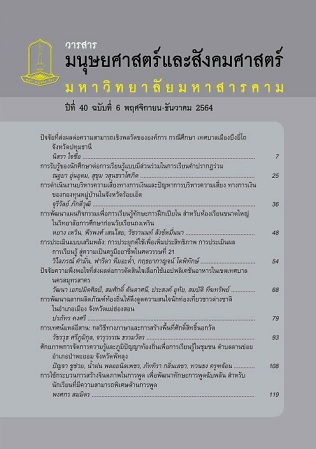The Students’ Perceptions of the Involvement Load Hypothesis on Collocation Learning
Main Article Content
Abstract
The purposes of the study were to explore the students’ perceptions of the ILH and to investigate the perception of their collocation learning under the Involvement Load Hypothesis (ILH). The ILH proposed by Laufer and Hulstijin (2001) was claimed its effect on vocabulary learning and retention due to its elements of the hypothesis. Six first-year English major students studying in a university in Thailand were involved in the semi-structured interview. Before attending the interview, the students were asked to complete collocation exercises developed based on the ILH. The students needed to study collocations in the learning materials which were the sentence examples and a page of the collocation in the Oxford Collocation dictionary to finish the exercises. The result revealed a positive perception of learning collocation based on the ILH. Besides, the students’ reflections on the ILH and collocation learning from the learning materials were also discussed in the article.
Article Details
References
Chen, Y. (2016). Dictionary use for collocation production and retention: A call-based study. International Journal of Lexicography, 30(2), 225-251. Available at: https://doi.org/10.1093/ijl/ecw005
Craik, F. I. M. & R. S. Lockhart. (1972). Levels of processing: A framework for memory research. Journal of Verbal Learning and Verbal Behavior, 11, 671-684. Available at: https://doi.org/10.1016/S0022-5371(72)80001-X
Dankittikul, T. & Laohawiriyanon, C. (2018). Effect of Paper-based Concordance on Thai Low Proficiency English Language Learners’ Logical Connector Knowledge. Veridian E-Journal, 11(4), 61-78.
Erman, B. & Warren, B. (2000). The idiom principle and the open choice principle. TEXT, 20(1), 29-62. Available at: https://doi.org/10.1515/text.1.2000.20.1.29
Fallahrafie, Z., Rahmany, R. & Sadeghi, B. (2015). The effect of task-based teaching on incidental vocabulary learning in English for specific purposes. Cumhuriyet science journal, 36(3), 836-846.
Feng, T. (2015). Involvement load in translation tasks and EFL vocabulary learning. The New English Teacher, 9(1), 83–101.
Hill, J. (2000). Revising priorities: From grammatical failure to collocational success. In M.Lewis (ed.). Teaching collocation: Further development in the lexical approach. (pp. 47-69). Hove, England: Language Teaching Publications.
Hulstijn, J. H. & Laufer, B. (2001). Incidental vocabulary acquisition in a second language: The construct of task-induced involvement. Applied Linguistics, 22(1), 1–26. Available at: https://doi.org/10.1093 /applin/22.1.1.
Laufer, B. & Paribakht, T. (1998). The relationship between passive and active vocabularies: Effects of language learning context. Language Learning, 48, 365–391. Available at: https://doi.org/10.1111/0023-8333.00046.
Lewis, M. (2000). Teaching collocation: Further development in the lexical approach. London: Language Teaching Publications.
Mahvelati, E. H. (2019). Explicit and implicit collocation teaching methods: Empirical research and issues. Advances in Language and Literary Studies, 10(3), 105-116. Available at: https://doi.org/ 10.7575/aiac.alls.v.10n.3p.105
Phoocharoensil, S. (2011). Collocation errors in EFL learners’ interlanguage. Journal of education and practice, 2(3), 103-120.
Pourakbari, A. A. & Biria, R. (2015). Efficacy of task-induced involvement in incidental lexical development of Iranian senior EFL students. English Language Teaching, 8(5), 122–131. Available at: https://doi.org /10.5539/ELT.V8N5P122.
Shin, D. & Nation, P. (2008). Beyond single words: The most frequent collocations in spoken English. ELT journal, 62(4), 339-348. Available at: https://doi.org/10. 1093/ELT/ CCM091.
Shokouhi, H. & Mirsalari, G. (2010). Collocational knowledge versus general linguistic knowledge among Iranian EFL learners. TESL-EJ, 13(4), 9.
Snoder, P. (2017). Improving English learners’ productive collocation knowledge: The effects of involvement load, spacing, and intentionality. TESL Canada Journal, 34(3), 140-164. Available at: https://doi.org/10.18806/TESL.V34I3.1277
Suvarnamani, S. (2017). A study of grammatical and lexical errors in descriptive writing of first year Arts Students at Silpakorn University. Silpakorn university journal of social sciences, humanities, and arts, 17(2), 239-264.
Wasuntarasophit, S. (2015). Explicit instruction of collocations: An impact on learners’ use and perceptions. Journal of humanities and social sciences, 11(2), 37-71.
Woolard, G. (2000). Collocation-encouraging learner independence. In M. Lewis (ed.). Teaching collocation: Further development in the lexical approach. (pp. 28-46). London: Language Teaching Publications.
Yaemtui, W. & Phoocharoensil, S. (2019). Effectiveness of Data-driven Learning (DDL) on Enhancing High-proficiency and Low-proficiency Thai EFL Undergraduate Students’ Collocational Knowledge. The Asian EFL Journal, 23(3.2), 290-314.

